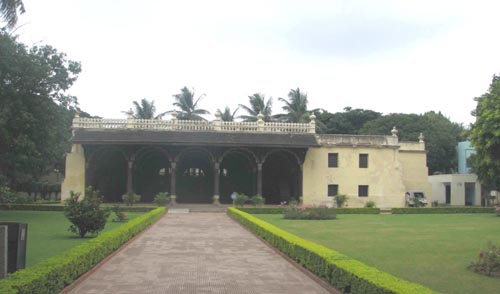Tipu's Fort

Information on Tipu's Fort (Bangalore, Karnataka) - History & Architecture
Tipu's Fort also known as the fort of Bangalore was built during the reign of Tipu Sultan in Karnataka. The fort also includes 'the Tipu Sultan's Summer Palace' and the armory used by Tipu Sultan. Built in the year 1791 the fort is one of the oldest in the history.
Tipu's Fort Architecture
The architectural beauty of the fort has influenced the state government of Karnataka to use the fort for tourism purposes. The fort which was a two storied monument was mainly constructed with the extensive use of stone and mud. The construction of the structure also used teak to make some parts of the pillars and the arches. Notably, there were primarily four rooms the first floor of the monument which was used in the corners of first floor which were mainly used to accommodate women and was termed as Zenana quarters. The interiors of the monument were filled with floral design paintings mostly in the walls of the palace. The palace also contains paintings that depicts that the throne of Tipu in precise. These paintings were covered with gold sheets and fixed with rich emerald stones. The design and architecture of the monument is heavily influenced from the 'Indo-Islamic architecture'. Portraits of important people during the rule of Tipu sultan were also placed in the interior walls of ground floor.
Tipu's Fort History
The construction of the fort was commenced by Hyder Ali during the 1760s and completed it in 1791. This two storied building was mainly used by Tipu sultan as his residence after its completion under the guidance of Ali. However, after the death of Tipu sultan, the fort was used by the brutish government to conduct the operations of its secretariat. However, by the year 1868, the fort was left by the British. In the present day scenario, the fort is being used by the government of Karnataka as a tourist attraction. It is being believed that King Tipu used to have his durbar in the eastern part of the upper storey of the monument. Another interesting fact about this particular monument is that Tipu Sultan had once taken the oath not to use the entire building before he/his army defeat the British army. However, after the defeat and the death of the King during 'the Anglo-Mysore War', the British administration took control over the fort and sold most parts of the fort through auctioning. It is believed the part of the throne painting of Tipu was so much costly that one single person was not been able to buy the whole structure. Hence, the British dismantle the throne of Tipu and sold it separately. Notably, some converted parts of the fort into museum contains crown along with the clothes of Tipu in gold stands.
Tipu's Fort Tourism Importance
In the present day context, the monument is used by the state government to serve the tourism sector. The palace is open for the visitors regularly except for Sundays. The entry fees for the Indian visitors are kept at 5 INR while for the foreign tourist the price of the ticket is 100 INR. The use of the camera is allowed inside the fort for the visitors. The visitors mainly appreciate the picturesque of the fort along with the quite atmosphere that prevail within the fort. Visitors are also deemed to be quite impressed with the rich and unique architecture of the fort especially the use of teak in designing the pillars. It is one of the 'must visit' places for the tourist in the city of Bangalore.
- Bangalore Monuments
- Bagalkot Monuments
- Belgaum Monuments
- Bellary Monuments
- Bidar Monuments
- Bijapur Monuments
- Chitradurga Monuments
- Coorg Monuments
- Dakshina Kannada Monuments
- Gadag Monuments
- Gulbarga Monuments
- Hassan Monuments
- Mysore Monuments
- Raichur Monuments
- Uttara Kannada Monuments
- Yadgir Monuments
- Andaman Nicobar Monuments
- Andhra Pradesh Monuments
- Assam Monuments
- Bihar Monuments
- Chhattisgarh Monuments
- New Delhi Monuments
- Goa Monuments
- Gujarat Monuments
- Haryana Monuments
- Himachal Pradesh Monuments
- Jammu and Kashmir Monuments
- Karnataka Monuments
- Kerala Monuments
- Madhya Pradesh Monuments
- Maharashtra Monuments
- Odisha Monuments
- Punjab Monuments
- Rajasthan Monuments
- Tamil Nadu Monuments
- Telangana Monuments
- Uttar Pradesh Monuments
- West Bengal Monuments